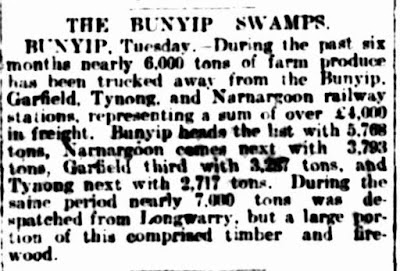The Dandenong Advertiser reported on January
27, 1916 that the new rifle range for the
Garfield Rifle Club was formally opened on Saturday by Mr Thomas Roxburgh of
Melbourne. In addressing the gathering Mr Roxburgh emphasised the necessity for
all young men to fit themselves for the defence of their country. Thomas Roxburgh
was a Shipping Agent who, in 1912, planted the first commercial crop of
asparagus ever grown in Victoria at his farm on Fallon Road, Vervale. His
property was called Cheriton Park, though locally it was referred to as
Roxburgh Park.
The same
article reported that bush fires have
been burning in all directions around the township for the last three days. On
Sunday morning they approached as close as the State School fence, but
fortunately no damage was done to property. The principal sufferer was Mr T. W
Jefferson, who lost about 20 cords of firewood.
The Argus reported on February 22 about another
fire in Garfield At about 1 o’clock this morning the general store occupied by Messrs E.
Harcourt and Co. together with practically the whole stock, was totally
destroyed by fire. The fire was first noticed by George Scotland, a baker
employed by Mr G. Bird. It was then burning on the extreme eastern side of the
building and had apparently started on the outside. This was the second time
within eight months that Harcourt and Co have had their premises burnt.
On March 31 the
Gippsland Mercury had the headline ‘A
Brotherly Affray’ - Two brothers named
Borthwick from England were shot today on a farm at Garfield South. A dispute
is said to have arisen over farm matters. A third man is in the Warragul
Hospital with a shot wound in his cheek. Neither brother is fatally injured.
Another violent
incident made the news on June 9 in the Dunmumkle
Standard (a newspaper based around the Murtoa, Rupanyup area). At Garfield on Sunday as a result of a
quarrel, an old man named John Munro was struck on the head with an axe. Munro,
in company with three others, was in his hut when a man known as “Matt the
Austrian” arrived. A quarrel occurred. Munro put the Austrian outside, but
finding an axe the Austrian smashed the window. Munro went to stop him and was
attacked receiving a terrible gash on the left side of the head and several
heavy blows with the back of the axe on the muscles of the back whilst he was
on the ground. The police who were sent for are now endeavouring to trace the
assailant.
The Age July 1, 1916
On July 1, The Age reported that a Mr Hull from Garfield was walking along a
lonely track when he came across the body of a dead man. Constable Anstee of
Bunyip was called and the remains were conveyed to the Iona Hotel at Garfield.
The body was decomposed and Dr Cowan who conducted the inquiry was of the
opinion that the death took place at least a month ago. From letters on the
body it is thought that the man’s name was Peter Lynch of Cork, Ireland. His
remains were buried at the Bunyip cemetery. I’d imagine that the current
owners of the Iona Hotel are glad that deceased bodies are no longer conveyed
to their establishment.
The Dandenong Advertiser reported on another fire on August 3. Mr R. Lennox of Iona had his large hay shed
containing 50 tons of prime hay, a quantity of chaff and sundry articles being
consumed in the flames. Sadly for Mr
Lennox the shed was not insured and the fire had been started by his little child, a boy of tender years.
The same
article also reported that Garfield residents had a very successful jumble fair; articles of every description being
collected by a committee of local ladies and £40 was raised for the Red Cross.
The Dandenong Advertiser had a report on September 21 about a
concert and Queen Carnival held on the 13th. Miss Kathleen Scanlon ‘Queen
of Erin’ proved to be the winner; the other contestants being Mrs Aspinall, ‘Queen
of England’, Mrs M. Lennan, ‘France’ and Miss Park who represented ‘Belgium’ The competition was initiated by Mrs
Aspinall and was entered into with spirit by the local ladies. The function raised £70. Mrs Jean Aspinall was
the wife of William Aspinall, the Bank Manager.
The Dandenong Advertiser of September 28
reported on recent floods which caused
enormous damage and great suffering in many homes. It reported the sad news that a son of Mr T.
Cunningham of Tynong was drowned in a drain in front of his house. Mrs Cunningham saw her son disappear, but
was powerless to save him. The same
flood claimed the life of a boy from Koo-Wee-Rup, Lyle Raymond Loveday, who was
drowned whilst out rabbiting. The paper reports that the boy was an exceptionally promising lad and would have been 12 years
old on the day after the fatality.
Finally we will
end 1916 as we began with yet another fire in Garfield. The Argus of December 27 reported that at about 3 o’clock the day before a four roomed dwelling owned by Mr
Gaghin and used as a men’s quarter was burnt. The building was insured for £100.








